Pipridae – Manakins
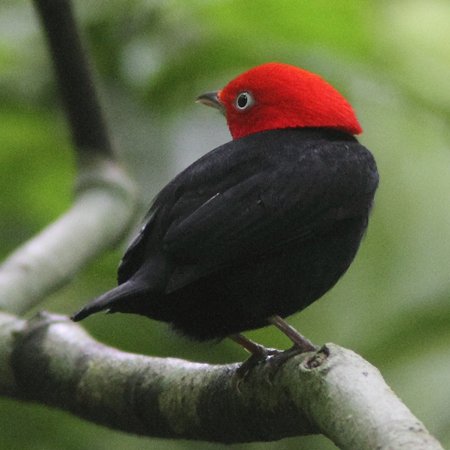
The manakins are a family of small suboscine passerine birds of the taxonomic family Pipridae. The group contains some 55 species in 16 genera, distributed through the American tropics. The common name is derived from Middle Dutch mannekijn meaning ‘little man’, which, confusingly, is also the source of the different groups of birds named mannikins.
They range in size from 7cm to 15cm and in weight from 8gm to 30gm. The genus Tyranneutes comprise the smallest manakins, the genus Chiroxiphia are believed to be the largest (since the Schiffornis genus are no longer considered manakins). They are compact stubby birds with short tails, broad and rounded wings, and big heads. The bill is short and has a wide gape Females and first-year males have dull-green plumage; most species are sexually dichromatic in their plumage, the males being mostly black with striking colours in patches, and in some species having long, decorative tail or crown feathers or erectile throat feathers. In some species, males from two to four years old have a distinctive subadult plumage.
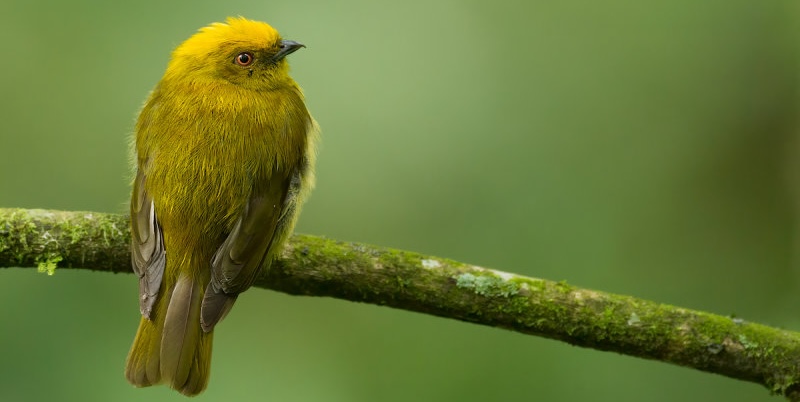
Yellow-headed Manakin Chloropipo flavicapilla – ©Dubi Shapiro
The syrinx is distinctive in manakins, setting them apart from the related families Cotingidae and Tyrannidae. Furthermore, it is so acutely variable within the group that genera and even species can be identified by the syrinx alone, unlike birds of most oscine families. The sounds made are whistles, trills, and buzzes.
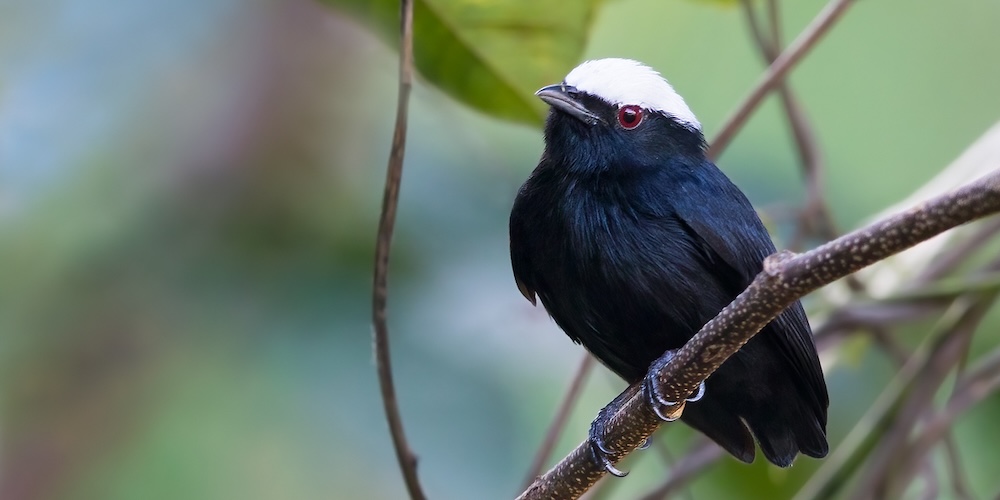
White-crowned Manakin Pseudopipra pipra – ©Dubi Shapiro
Manakins occur from southern Mexico to northern Argentina, Paraguay, and southern Brazil, and on Trinidad and Tobago as well. They are highly arboreal, being almost exclusively forest and woodland birds. Most species live in humid tropical lowlands, with a few in dry forests, river forests, and the subtropical Andes. Some highland species have altitudinal migrations.
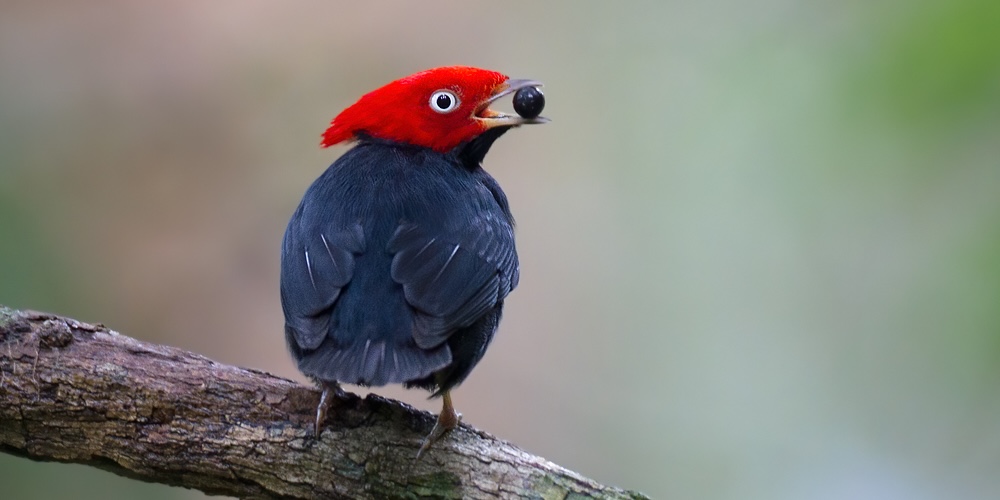
Round-tailed Manakin Ceratopipra chloromeros – ©Dubi Shapiro
Manakins feed in the understorey on small fruit (but often remarkably large for the size of the bird) including berries, and to a lesser degree, insects. Since they take fruit in flight as other species hawk for insects, they are believed to have evolved from insect-eating birds. Females have big territories from which they do not necessarily exclude other birds of their species, instead feeding somewhat socially. Males spend much of their time together at courtship sites. Manakins sometimes join mixed feeding flocks.
Many manakin species have spectacular lekking courtship rituals, which are particularly elaborate in the genera Pipra and Chiroxiphia.

Blue Manakin Chiroxiphia caudata – ©Dubi Shapiro
The members of the genera Machaeropterus and Manacus have heavily modified wing feathers, which they use to make buzzing and snapping sounds. The building of the nest, which is an open cup, generally built low in vegetation, is undertaken by the female alone. This is also true of incubation, which takes around 18 to 21 days, and the care of the young, lasting for 13 to 15 days. This is because most manakins do not form stable pairs. An exception is the Helmeted Manakin, which does form pairs, but even in this case, the male’s contribution is limited to defending the territory. The normal clutch is two eggs, which are buff or dull white, marked with brown.
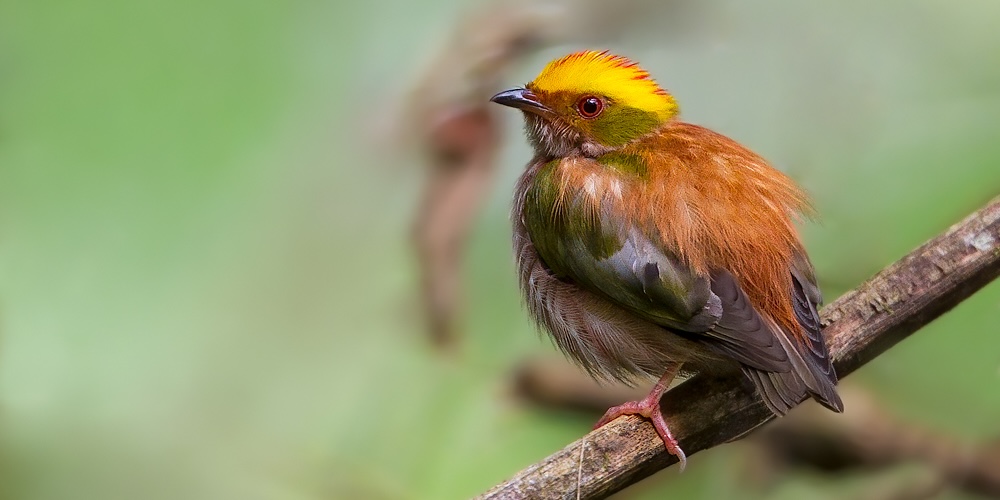
Fiery-capped Manakin Machaeropterus Pyrocephalus – ©Dubi Shapiro
Lekking polygyny seems to have been a characteristic of the family’s original ancestor, and the associated sexual selection led to an adaptive radiation in which relationships can be traced by similarities in displays. An evolutionary explanation connecting lekking to fruit-eating has been proposed.
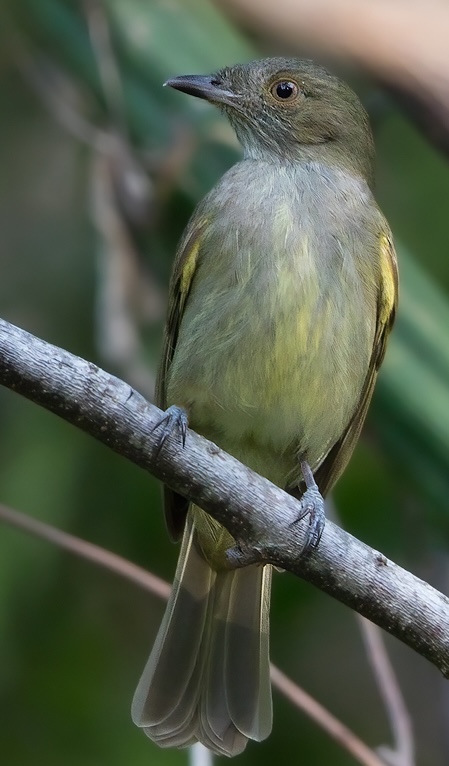
Pale-bellied Tyrant-Manakin Neopelma pallescens – ©Dubi Shapiro
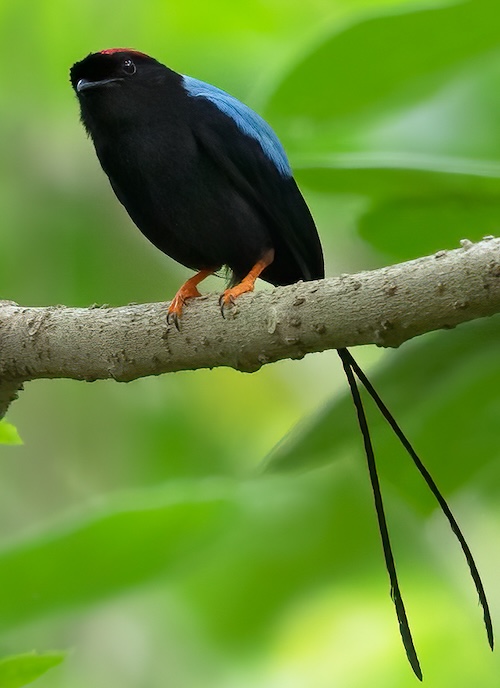
Long-tailed Manakin Chiroxiphia linearis – ©Dubi Shapiro
-
Number of bird species: 55
(As at July 2025)
The unified AviList identifies 55 species in this family; they are:
Tiny Tyrant-Manakin Tyranneutes virescens
Dwarf Tyrant-Manakin Tyranneutes stolzmanni
Pale-bellied Tyrant-Manakin Neopelma pallescens
Saffron-crested Tyrant-Manakin Neopelma chrysocephalum
Wied’s Tyrant-Manakin Neopelma aurifrons
Serra do Mar Tyrant-Manakin Neopelma chrysolophum
Sulphur-bellied Tyrant-Manakin Neopelma sulphureiventer
Pin-tailed Manakin Ilicura militaris
Golden-winged Manakin Masius chrysopterus
White-ruffed Manakin Corapipo altera
White-bibbed Manakin Corapipo leucorrhoa
White-throated Manakin Corapipo gutturalis
Araripe Manakin Chiroxiphia bokermanni
Helmeted Manakin Chiroxiphia galeata
Lance-tailed Manakin Chiroxiphia lanceolata
Long-tailed Manakin Chiroxiphia linearis
Blue-backed Manakin Chiroxiphia pareola
Yungas Manakin Chiroxiphia boliviana
Blue Manakin Chiroxiphia caudata
Black Manakin Xenopipo atronitens
Olive Manakin Xenopipo uniformis
Yellow-headed Manakin Chloropipo flavicapilla
Jet Manakin Chloropipo unicolor
Green Manakin Cryptopipo holochlora
Choco Manakin Cryptopipo litae
Velvety Manakin Lepidothrix velutina
Blue-crowned Manakin Lepidothrix coronata
Snow-capped Manakin Lepidothrix nattereri
Golden-crowned Manakin Lepidothrix vilasboasi
Opal-crowned Manakin Lepidothrix iris
Orange-bellied Manakin Lepidothrix suavissima
White-fronted Manakin Lepidothrix serena
Blue-rumped Manakin Lepidothrix isidorei
Cerulean-capped Manakin Lepidothrix coeruleocapilla
Orange-crested Manakin Heterocercus aurantiivertex
Yellow-crested Manakin Heterocercus flavivertex
Flame-crested Manakin Heterocercus linteatus
White-collared Manakin Manacus candei
Orange-collared Manakin Manacus aurantiacus
Golden-collared Manakin Manacus vitellinus
White-bearded Manakin Manacus manacus
Crimson-hooded Manakin Pipra aureola
Wire-tailed Manakin Pipra filicauda
Band-tailed Manakin Pipra fasciicauda
Club-winged Manakin Machaeropterus deliciosus
Striolated Manakin Machaeropterus striolatus
Painted Manakin Machaeropterus eckelberryi
Kinglet Manakin Machaeropterus regulus
Fiery-capped Manakin Machaeropterus pyrocephalus
White-crowned Manakin Pseudopipra pipra
Scarlet-horned Manakin Ceratopipra cornuta
Red-capped Manakin Ceratopipra mentalis
Golden-headed Manakin Ceratopipra erythrocephala
Red-headed Manakin Ceratopipra rubrocapilla
Round-tailed Manakin Ceratopipra chloromeros
-
Pipridae
Family AccountIllustrated List -
Pipridae
Family AccountThe manakins are a family, Pipridae, of small suboscine passerine birds. The group contains 55 species distributed through the American tropics.
Given the number of species in this family, Fatbirder does not provide quick links to all of them. However, the entries below do include links to representatives of every genera and some of the most often encountered species.
-
Black Manakin Xenopipo atronitens
Species AccountSmall bird of dry scrub enclaves in rainforest regions. All-black male is distinctive; compared to other manakins, note longish tail and blue bill in both... -
Black Manakin Xenopipo atronitens
Species AccountSound archive and distribution map. -
Black Manakin Xenopipo atronitens
Species AccountThe black manakin (Xenopipo atronitens) is a species of bird in the family Pipridae. It is found in Bolivia, Brazil, Colombia, French Guiana, Guyana, Peru... -
Dwarf Tyrant-Manakin Tyranneutes stolzmanni
Species AccountTiny manakin of Amazonian rainforest. Dull olive-green with a lighter, yellowish belly, a short tail, and dark gray legs. -
Dwarf Tyrant-Manakin Tyranneutes stolzmanni
Species AccountThe dwarf tyrant-manakin or dwarf tyranneutes (Tyranneutes stolzmanni) is a species of bird in the family Pipridae. -
Dwarf Tyrant-Manakin Tyranneutes stolzmanni
Species AccountSound archive and distribution map. -
Flame-crested Manakin Heterocercus linteatus
Species AccountFairly large manakin. Males are distinctive, with a black head and an orange-red center of the crown that is often concealed; upperparts olive and... -
Flame-crested Manakin Heterocercus linteatus
Species AccountThe flame-crested manakin (Heterocercus linteatus) is a species of bird in the family Pipridae. It is found in Bolivia, Brazil, and Peru. -
Flame-crested Manakin Heterocercus linteatus
Species AccountSound archive and distribution map. -
Golden-headed Manakin Ceratopipra erythrocephala
Species AccountSound archive and distribution map. -
Golden-headed Manakin Pipra erythrocephala
Species AccountA chunky little bird of lowland forest in northern South America. Male is distinctive with a black body and bright golden head. -
Golden-headed Manakin Pipra erythrocephala
Species AccountThe golden-headed manakin (Ceratopipra erythrocephala) is a small passerine bird which breeds in tropical Central and South America in both wet and dry forests, secondary growth and plantations. -
Golden-winged Manakin Masius chrysopterus
Species AccountSound archive and distribution map. -
Golden-winged Manakin Masius chrysopterus
Species AccountChunky little bird of Andean cloud forest from around 800–2000 m. Male mostly jet black with fancy golden forecrown and black horns. -
Golden-winged Manakin Masius chrysopterus
Species AccountThe golden-winged manakin (Masius chrysopterus) is a species of bird in the family Pipridae. It is the only member of the monotypic genus, Masius. -
Green Manakin Cryptopipo holochlora
Species AccountScarce and inconspicuous rainforest bird found along the lower slopes of the eastern Andes and adjacent lowlands. -
Green Manakin Cryptopipo holochlora
Species AccountThe green manakin (Cryptopipo holochlora) is a species of bird in the family Pipridae. It occurs in humid forest in lowlands and foothills... -
Green Manakin Cryptopipo holochlora
Species AccountSound archive and distribution map. -
Helmeted Manakin Chiroxiphia galeata
Species AccountMales are striking with a mostly glossy black body, but with a red forehead, crest, and back. Females are uniformly olive-green and also crested. -
Helmeted Manakin Chiroxiphia galeata
Species AccountThe helmeted manakin (Chiroxiphia galeata) is a species of small passerine bird in the manakin family Pipridae. -
Helmeted Manakin Chiroxiphia galeata
Species AccountSound archive and distribution map. -
Kinglet Manakin Machaeropterus regulus
Species AccountChunky little, short-tailed bird of lowland and foothill forest. Male is distinctive with bright red crown and bold white stripes on reddish belly. -
Kinglet Manakin Machaeropterus regulus
Species AccountThe striped manakin (Machaeropterus regulus) is a small South American species of bird in the Pipridae family. Its distribution is highly disjunct: The nominate subspecies is found in Atlantic Forest in eastern Brazil, while the striolatus group is found in forests in western Brazil, northeastern Peru, eastern Ecuador, Colombia, and western and southern Venezuela. -
Kinglet Manakin Machaeropterus regulus
Species AccountSound archive and distribution map. -
Pin-tailed Manakin Ilicura militaris
Species AccountSound archive and distribution map. -
Pin-tailed Manakin Ilicura militaris
Species AccountThe pin-tailed manakin (Ilicura militaris) is a suboscine species of bird within the manakin family, Pipridae. -
Pin-tailed Manakin Ilicura militaris
Species AccountVery small manakin with pointed central tail feathers that is found in humid forests. Males are striking with a black crown... -
Red-capped Manakin Ceratopipra mentalis
Species AccountThe red-capped manakin (Ceratopipra mentalis) is a species of bird in the Pipridae family. It is found in Belize, Colombia, Costa Rica, Ecuador, Guatemala, Honduras, Mexico, Nicaragua, Peru and Panama. Its natural habitat is subtropical or tropical moist lowland forests. -
Red-capped Manakin Ceratopipra mentalis
Species AccountSound archive and distribution map. -
Sulphur-bellied Tyrant-Manakin Neopelma sulphureiventer
Species AccountLarge, tan manakin. Longer-tailed with a more upright posture than other smaller manakins. Forages singly or in pairs in the low... -
Sulphur-bellied Tyrant-Manakin Neopelma sulphureiventer
Species AccountThe sulphur-bellied tyrant-manakin (Neopelma sulphureiventer), or sulphur-bellied neopelma, is a species of bird in the family... -
Sulphur-bellied Tyrant-Manakin Neopelma sulphureiventer
Species AccountSound archive and distribution map. -
White-bearded Manakin Manacus manacus
Species AccountFull species account… -
White-bearded Manakin Manacus manacus
Species AccountSound archive and distribution map. -
White-bearded Manakin Manacus manacus
Species AccountFairly common and widespread through much of South America. Males are distinctive with white throat, sharply defined black cap, black back and wing... -
White-bearded Manakin Manacus manacus
Species AccountThe white-bearded manakin (Manacus manacus) is a small passerine bird which breeds in tropical South America. It is found from Colombia, Venezuela and Trinidad south to Bolivia and northern Argentina. -
White-crowned Manakin
Species AccountPseudopipra pipra Sound archive and distribution map. -
White-crowned Manakin
Species AccountPseudopipra pipra It was traditionally placed in the genus Pipra, but is now placed in its own monotypic genus Pseudopipra. -
White-crowned Manakin
Species AccountPseudopipra pipra Small, plump, and short-tailed. Unmistakable male is glossy black with clean white cap. Female is dull olive-green and similar to other manakins. -
White-fronted Manakin Lepidothrix serena
Species AccountThe white-fronted manakin (Lepidothrix serena) is a species of bird in the Pipridae family, the manakins. It is native to French Guiana, Guyana, Suriname and northeastern Brazil where it inhabits subtropical and tropical moist lowland forest. -
White-fronted Manakin Pipra serena
Species AccountFull species account… -
White-ruffed Manakin Corapipo altera
Species AccountA plump, short-tailed little bird. Male is distinctive: entirely glossy blue-black with striking white throat. -
White-ruffed Manakin Corapipo altera
Species AccountThe white-ruffed manakin (Corapipo altera) is a sub-oscine (Tyranni), passerine bird in the manakin family. -
White-ruffed Manakin Corapipo altera
Species AccountSound archive and distribution map. -
Wire-tailed Manakin Pipra filicauda
Species AccountSpectacular manakin with very long tail filaments and piercing white eyes. -
Wire-tailed Manakin Pipra filicauda
Species AccountThe wire-tailed manakin (Pipra filicauda) is a species of bird in the family Pipridae. It forms a superspecies with both the Band-tailed Manakin (Pipra fasciicauda) and the Crimson-hooded Manakin (Pipra aureola) -
Wire-tailed Manakin Pipra filicauda
Species AccountSound archive and distribution map. -
Yellow-headed Manakin Chloropipo flavicapilla
Species AccountRare and local in cloud forest from around 1,200-2,400m. Unique: mostly olive with contrasting yellow crown and dull reddish eye. -
Yellow-headed Manakin Chloropipo flavicapilla
Species AccountThe yellow-headed manakin (Chloropipo flavicapilla) is a species of bird in the family Pipridae. It is found in Colombia and Ecuador. -
Yellow-headed Manakin Chloropipo flavicapilla
Species AccountSound archive and distribution map.
